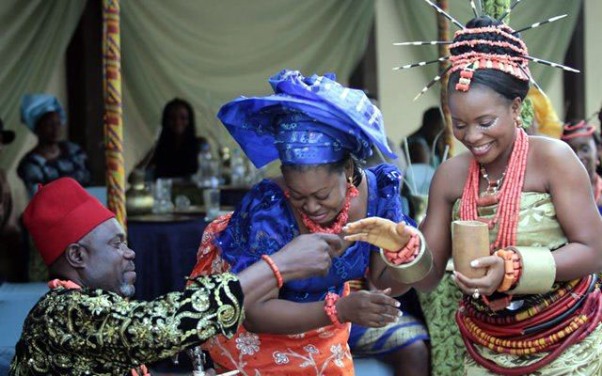Kwe-kwe in Guyana resulted from the fusion of the marriage practices of several different African cultural groups who were enslaved during the African Holocaust. Careful examination of West African marriage ceremonies today can help us to get an insight into the origins of some of the customs that influenced Guyanese kwe-kwe.
Igbo Marriage
Igba nkwu Nwayi (wine carrying)
Depending on the locality, the wedding procession begins with the bride-to-be and her entourage of ten or more unmarried female friends, dancing as they enter the compound. Some of the women in the group carry small parcels of food on plates which they offer to the guests as they move behind the bride- to-be, who is wearing a coral necklace and headdress.
In the Igbo cultures of southern Nigeria, coral was a valued commodity, symbolizing prominence or royalty. However, today, corals are worn more as a romantic gesture. But coral’s value dates back to biblical times when Solomon compared the value of a good wife as being more precious than corals (Pr. 31.10).
As the betrothed and her entourage dance and intermingle with the guests, they shower her and her entourage with money as a sign of appreciation. They place the money on the betrothed’s forehead, around her, or in her path. Protocol means that she does not pick it up; that is left to some of the women accompanying her and is given to her after the ceremony.
At the end of the entrance dance, she pays tribute to her father and the village head, who are seated in the front row. The chief wears the red Ozo hat, as does other respected elders in the community. The bride-to be acknowledges them by kneeling and bowing before them. She in turn is acknowledged, by their touching of her back; after which, the procession leaves the compound by a different exit.
After they have left, it is the turn of the groom-to-be, to lead in his group of family and friends. He and his entourage also dance as they enter. The groom wears a coral necklace and the Ozo indicating that he is following in his father’s footsteps. Again, money is sprayed at the betrothed as he and his group make their way around greeting their guests. After that, they salute the bride’s family, then leave. However, before the bride-to-be returns, her betrothed and some of his entourage return and find a place to sit among the guests.
When the bride-to-be and her group enter once more, she is dressed in her wedding attire. Once again, she and her group greet her guests as they dance around the compound before making her way to her father and the village elders, kneeling before them.
The wedding ceremony is presided over by the most senior elder or village head who gives a speech on marriage and its moral and cultural significance before giving the bride-to-be, a glass of palm wine. She does not drink it, but carries it around in search of her betrothed. This a playful moment for the male guests, as each one calls and beckons her over in their claims of being her betrothed. The bride-to-be plays along with them and may walk up to a male guest, gesturing to offer the drink but snatch it back. All the while, money continues to be sprayed at her.
After finding her betrothed, she kneels before him and he will touch her on the back in acknowledgment. She takes a sip of the palm wine before offering him a drink. By doing this, she is making a public declaration of her respect, love and integrity.
When he sips the wine he is declaring that he has accepted her love. He then places money in the empty glass and together they dance their way to her father and the village elders to be blessed and given marital instructions. This time, they are on their own; the group do not follow them. This ceremony takes place after the bride price was previously negotiated and agreed by the bride’s village. In effect the traditional wedding is an amalgamation of different components that is collectively called ‘alumdi na nwunye.’






